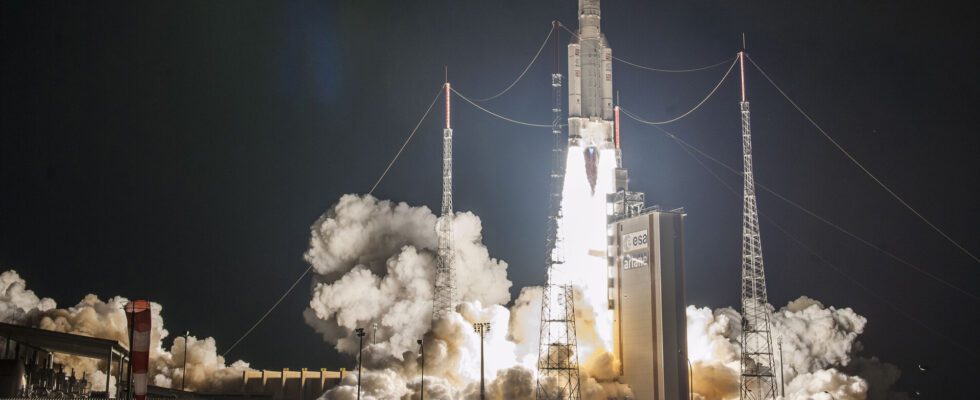Europe must use its latest launchers this year in the light (Vega) and heavy (Ariane) segments. However, the successors to Vega and Ariane 5 have encountered difficulties in recent months. They should make their debut at the end of 2023, exposing Europe to a more or less pronounced capacity gap.
It was January 10. Presenting its good wishes for the new year, the Arianespace account immediately revealed the next mission for the Ariane 5 rocket: JUICE. Objective : visit the moons of Jupiter from 2030, thanks to a European probe. ” Happy New Year to the entire Arianespace team », replied ArianeGroup, which manufactures Ariane launchers.
Behind these friendly exchanges, however, space Europe has entered a crucial year. On all launcher segments (light, medium and heavy), the Old Continent finds itself in an uncomfortable position, limiting its room for maneuver to send satellites into space. These difficulties are likely to be felt throughout 2023.
Serial delays for Ariane 6…
On the heavy segment, the new Ariane 6 rocket is not yet ready to make its debut. The latest news is that it is due to make its maiden flight in the fourth quarter of 2023, after a three-year delay. However, at that time, space Europe will have no alternative solution in store to compensate for a possible delay: Europe will then no longer have any Ariane 5 rocket.
The last two copies of this rocket have already received their assignment: for the first, it will be the JUICE mission (one of the most important of the year), for takeoff announced on April 13. In mid-February, the teams behind this adventure indicated the arrival of the probe near Kourou. It is from the Guiana space center that the penultimate Ariane 5 rocket will launch.
Who doesn’t love a good #unboxing moment?! ?
Our beautiful #ESAJuice spacecraft arrived @EuropeSpaceport last week and we’re unpacking ready for launch preparations. Target launch date: 13 April! ?
More info coming soon! https://t.co/qlENO5VQUN#SaveTheDate #ExploreFarther pic.twitter.com/pZu5HF0wu5
— ESA's JUICE mission (@ESA_JUICE) February 13, 2023
After taking off for Jupiter, Arianespace will embark a few months later on flight VA261, which will mark the end of the long career of Ariane 5, which began in 1996. It will involve transporting two satellites, one for the French armies (Syracuse 4B, for secure communications), the other for the benefit of the German space agency (H2Sat).
Initially, the departure of JUICE should have been the last mission of Ariane 5. However, problems were observed on one of the two satellites – in this case, the delay was accumulated on H2Sat, reported La Tribune in mid-January . This mission, initially planned for 2022, has been postponed to January 2023 and then to June now.
After ? Space Europe will no longer have a sovereign rocket to carry heavy loads into orbit or into the solar system, at least as long as Ariane 6 is not operational. This capacity hole had already been identified last year, with yet another postponement of Ariane 6. To compensate, it would be necessary to resort to third parties, such as SpaceX or ULA.
A new light rocket that derails
On the intermediate segment, the Soyuz option is unthinkable because of the war in Ukraine triggered by Russia. The Western powers have chosen to massively sanction Moscow, which notably responded by depriving Europe of this launcher. From now on, this rocket takes off only from Russian bases or from the former USSR.
Finally, the light launcher segment also experienced severe turbulence after the loss, on the second flight, of the new Vega-C launcher. In question, the failure of a part in the second floor. Therefore, given the time required for the investigation and the corrective actions so that this does not happen again, the return to business of Vega-C will not take place before the end of the year.
However, there is relatively good news: the incident that affected the Vega-C occurred in a component that does not exist in the previous model (Vega). This gives Arianespace the opportunity to use its last two Vega launchers by the end of summer 2023. Then there will be a void that will only be filled when Vega-C is requalified.
Between Ariane 5 which is about to be retired, with two flights to complete, and Vega which is in the same situation, it is a delicate year for Europe in space, because of the difficulties encountered by the launchers to succeed them. It remains to be seen whether 2023 will be the year of the dates respected or whether other worries will transform it into annus horribilis.
Do you want to know everything about the mobility of tomorrow, from electric cars to pedelecs? Subscribe now to our Watt Else newsletter!
